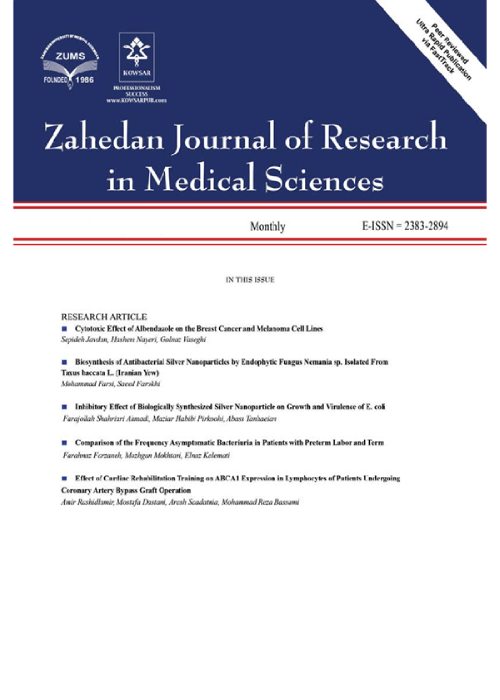Determination of the Pattern of Antibiotic Resistance and Investigation of Extended-Spectrum Beta-Lactamase Production of Enterobacteriaceae Isolates of Clinical Specimens
Author(s):
Abstract:
Background
Extended-spectrum beta-lactamase (ESBLs) producing bacteria are issued as a serious problem considering their ability to hydrolyze most of beta-lactam antibiotics. The outbreak of infections derived by ESBL-producing enterobacteriaceae is increasing throughout the world. Therefore, this study aims to determine a pattern of antibiotic resistance and investigate the extended-spectrum beta-lactamases production of enterobacteriaceae isolates separated from clinical specimens.Materials And Methods
In this study, 170 various strains of enterobacteriaceae isolated from clinical specimens in teaching hospitals of Arak cultured and identified applying standard methods during one year (2010-2011). The antibiotic resistance of isolates was investigated through disk Agar diffusion according to CLSI criteria. The resistant isolates against ceftazidime and cefotaxime antibiotics were studied through the combined disk test for the final confirmation of ESBL-production. The minimum inhibitory concentration was determined through micro broth dilution.Results
In this study, the resistance rate of various strains of enterobacteriaceae against amoxiclav, cefotaxime, ceftriaxone, ceftazidime, cefoxitin, cefotetan, meropenem and imipenem were respectively, 91.1%, 70%, 68.8%, 62.9%, 28.2%, 11.1%, 11.1% and 1.7%. Among 125 resistant enterobacteriaceae isolates against ceftazidime or cefotaxime, 108 isolates (86.4%) had ESBL-positive phenotype and 17 isolates (13.6%) had ESBL-negative phenotype. The MICs of the resistant isolates were indicated within a range of 16 to 512 µg/ml for ceftazidime and 64 to 512 µg/ml for cefotaxime.Conclusion
According to the results of this study, imipenem is the most effective antimicrobial antibiotic. On the other hand, the present study indicates that the bacteria within the family of ESBL producing enterobacteriaceae are highly prevalent among the patients. The increase in rate of such cases is often resulted by irrational antibiotic prescription. Application of new antimicrobials, limitation of the use of antimicrobial factors and increasing the utilization of infection control tools are all required in order to solve this problem.Keywords:
Language:
English
Published:
Zahedan Journal of Research in Medical Sciences, Volume:14 Issue: 8, 2012 Oct
Pages:
33 to 37
magiran.com/p1045839
دانلود و مطالعه متن این مقاله با یکی از روشهای زیر امکان پذیر است:
اشتراک شخصی
با عضویت و پرداخت آنلاین حق اشتراک یکساله به مبلغ 1,390,000ريال میتوانید 70 عنوان مطلب دانلود کنید!
اشتراک سازمانی
به کتابخانه دانشگاه یا محل کار خود پیشنهاد کنید تا اشتراک سازمانی این پایگاه را برای دسترسی نامحدود همه کاربران به متن مطالب تهیه نمایند!
توجه!
- حق عضویت دریافتی صرف حمایت از نشریات عضو و نگهداری، تکمیل و توسعه مگیران میشود.
- پرداخت حق اشتراک و دانلود مقالات اجازه بازنشر آن در سایر رسانههای چاپی و دیجیتال را به کاربر نمیدهد.
In order to view content subscription is required
Personal subscription
Subscribe magiran.com for 70 € euros via PayPal and download 70 articles during a year.
Organization subscription
Please contact us to subscribe your university or library for unlimited access!


